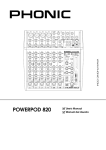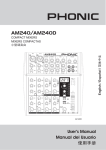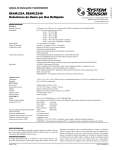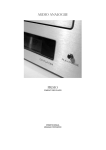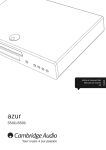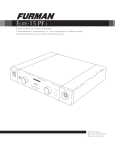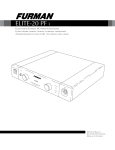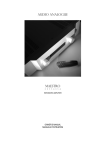Download English
Transcript
AM 240D AM 240 AM 240D User's Manual Manual del Usuario English AM 240 AM 240D Español COMPACT MIXERS MIXERS COMPACTAS ENGLISH . . . . . . . . . . . . . . . . . . . . . . . . . . . . . . . . . . . . . I ESPAÑOL . . . . . . . . . . . . . . . . . . . . . . . . . . . . . . . . . . . . . II APPENDIX . . . . . . . . . . . . . . . . . . . . . . . . . . . . . . . . . . . III V1.3 08/25/2014 AM240 / AM240D English USER'S MANUAL CONTENTS INTRODUCTION.....................................................................1 GETTING STARTED................................................................1 CHANNEL SETUP...................................................................1 MAKING CONNECTIONS........................................................2 CONTROLS AND SETTINGS...................................................3 DIGITAL EFFECT TABLE..........................................................5 SPECIFICATIONS....................................................................6 APPENDIX APPLICATIONS.........................................................................1 DIMENSIONS.........................................................................3 BLOCK DIAGRAMS..................................................................4 Phonic preserves the right to improve or alter any information within this document without prior notice AM240 / AM240D 3 IMPORTANT SAFETY INSTRUCTIONS English The apparatus shall not be exposed to dripping or splashing and that no objects with liquids, such as vases, shall be placed on the apparatus. The MAINS plug is used as the disconnect device, the disconnect device shall remain readily operable. Warning: the user shall not place this apparatus in the can be easily accessible. area during the operation so that the mains switch 1. Read these instructions before operating this apparatus. CAUTION 2. Keep these instructions for future reference. RISK OF ELECTRIC SHOCK DO NOT OPEN 3. Heed all warnings to ensure safe operation. 4. Follow all instructions provided in this document. 5. Do not use this apparatus near water or in locations where condensation may occur. 6. Clean only with dry cloth. Do not use aerosol or liquid cleaners. Unplug this apparatus before cleaning. 7. Do not block any of the ventilation openings. Install in accordance with the manufacturer’s instructions. 8. Do not install near any heat sources such as radiators, heat registers, stoves, or other apparatus (including . 9. Do not defeat the safety purpose of the polarized or grounding-type plug. A polarized plug has two blades with one wider than the other. A grounding type plug has two blades and a third grounding prong. The wide blade or the third prong is provided for your safety. If the provided plug does not into your outlet, consult an electrician for replacement of the obsolete outlet. 10. Protect the power cord from being walked on or pinched particularly at plug, convenience receptacles, and the point where they exit from the apparatus. 11. Only use attachments/accessories manufacturer. CAUTION: TO REDUCE THE RISK OF ELECTRIC SHOCK, DO NOT REMOVE COVER (OR BACK) NO USER SERVICEABLE PARTS INSIDE REFER SERVICING TO QUALIFIED PERSONNEL The lightning flash with arrowhead symbol, within an equilateral triangle, is intended to alert the user to the presence of uninsulated “dangerous voltage” within the product’ magnitude to constitute a risk of electric shock to persons. The exclamation point within an equilateral triangle is intended to alert the user to the presence of important operating and maintenance (servicing) instructions in the literature accompanying the appliance. WARNING: To reduce the risk of or electric shock, do not expose this apparatus to rain or moisture. CAUTION: Use of controls or adjustments or performance may result in of procedures other than those hazardous radiation exposure. by the 12. Use only with a cart, stand, tripod, bracket, or by the manufacturer, or sold with table the apparatus. When a cart is used, use caution when moving the cart/apparatus combination to avoid injury from tipover. 13. Unplug this apparatus during lighting storms or when unused for long periods of time. service personnel. 14. Refer all servicing to Servicing is required when the apparatus has been damaged in any way, such as power-supply cord or plug is damaged, liquid has been spilled or objects have fallen into the apparatus, the apparatus has been exposed to rain or moisture, does not operate normally, or has been dropped. 4 AM240 / AM240D INTRODUCTION We know how eager you are to get started – wanting to get the mixer out and hook it all up is probably your number one priority right now – but before you do, we strongly urge you to take a look through this manual. Inside, you will find important facts and figures on the setup, use and applications of your brand new mixer. If you do happen to be one of the many people who flatly refuse to read user manuals, then we just urge you to at least glance at the Instant Setup section. After glancing at or reading through the manual (we applaud you if you do read the entire manual), please store it in a place that is easy for you to find, because chances are there’s something you missed the first time around. Features • Two balanced mic/line inputs with 3-band EQ and lowcut • Four stereo inputs with +4/-10 select buttons • Post-fader AUX/EFX send on every input • Global +48V phantom power • CTRL RM and headphones outputs • Peak indicators on each mono input channel • Convenient RCA stereo I/O for MD, MP3 player • Stereo EFX send cue for better monitoring of individual channels • Balanced master output with 60mm fader control AM240D also features: • 32/40-bit digital stereo effect processor with 16 programs and one main parameter control AM240 / AM240D GETTING STARTED 1. Ensure all power is turned off on your mixer. To totally ensure this, the AC cable should not be connected to the unit 2. All faders and level controls should be set at the lowest level and all channels switched off to ensure no sound in inadvertently sent through the outputs when the device is switched on. All levels can be altered to acceptable degrees after the device is turned on using the channel setup instructions. 3. Plug any necessary equipment into the device’s various outputs. This could include amplifiers and speakers, monitors, signal processors, and/or recording devices. 4. Plug the supplied AC cable into the AC inlet on the back of the device and then into a power outlet of a suitable voltage. 5. Turn the power switch on and follow the channel setup instructions to get the most out of your equipment. CHANNEL SETUP 1. To ensure the correct audio level of the input channel is selected, each of the level input controls of the mixer should be turned counter-clockwise or down as far as they will go (which should be the -∞ mark) 2. No input other than the one being set should have any device plugged in. This will ensure the pure signal is used when setting channels 3. Set the level control of the channels you are setting to the 0 dB mark. 4. Ensure the channel has a signal sent to it similar to the signal that will be sent when in common use. For example, if the channel is using a microphone then you should speak or sing at the same level the performer normally would during a performance if a guitar is plugged into the channel, then the guitar should be strummed as it normally would be (and so on). This ensures levels are completely accurate and avoids having to reset them later. 5. Set the gain so the level meter indicators the audio Is around 0 dB. 6. This channel is now ready to be used; you can stop making the audio signal. 7. You can repeat the same process for other channels. 1 English Thank you for choosing one of Phonic’s many quality compact mixers. The AM series of mixers – designed by the ingenious engineers that have created a variety of mixers fantastic in style and performance in the past – displays similar proficiency that previous Phonic products have show; with more than a few refinements, of course. The AM series features full gain ranges, amazing low distortion levels, and incredibly wide dynamic ranges, just showing the dominance these small machines will have in the mixing World. MAKING CONNECTIONS Inputs and Outputs English 1. XLR microphone Jacks These jacks accept typical 3-pin XLR inputs for balanced and unbalanced signals. They can be used in conjunction with microphones – such as professional condenser, dynamic or ribbon microphones – with standard XLR male connectors, and feature low-noise preamplifiers, serving for crystal clear sound replication. Each of the AM series mixers features one standard XLR microphone inputs for your convenience. NB. When these inputs are used with condenser microphones, the Phantom Power should be activated. However, when the Phantom Power button is engaged, single ended (unbalanced) microphones and instruments should not be used on the mic inputs. 2. Line Inputs This input accepts typical ¼” TRS or TS inputs, for balanced or unbalanced signals. There are various numbers of these inputs depending which mixer you are using. They can be used in conjunction with various line level devices such as keyboards, drum machines, electric guitars, and a variety of other electric instruments. 3. Stereo Channels Each of the AM series mixers feature a few stereo channels thrown in for maximum flexibility. Each of these stereo channels features two ¼” TRS phone jacks, for the addition of various line level input devices, such as electric keyboards, guitars and external signal processors or mixers. These stereo channels can also be used as mono channels, where the signal from any ¼” phone jack plugged into the left stereo input will cause the signal to be duplicated to the right input also. This does not work in reverse. 5. AUX / EFX Send These ¼” TS outputs may be used to connect to an external digital effect processor, or even an amplifier and speakers (depending on your desired settings) to the mixer. 6. Phones This stereo output port is suited for use with headphones, allowing monitoring of the mix. The audio level of this output is controlled using the Phones/Control Room control. 7. 2T Record / Record Out These outputs will accommodate RCA cables, able to be fed to a variety of recording devices such as MP3 recorders and laptop computers. 8. 2T Return These RCA inputs are used to connect the mixer with external devices, such as tape and CD players, or even laptop computers. The received signal will be fed to either the Main L/R or Phone mixes. 9. Control Room Outputs These two 1/4” phone jack outputs send the signal from the Control Room / Phones feed, the level of which is determined by the control on the face of the mixer. This output has extensive use. For example, it can be used to feed active monitors for the monitoring of audio signals within a sound booth. Alternatively it can be used as an additional auxiliary. 4. Main L and R Outputs These two ports will output the final balanced line level signal send from the main mix. The primary purpose of these jacks is to send the main output to external devices, which may include power amplifiers (and, in-turn, a pair of speakers), other mixers, as well as a wide range of other possible devices (equalizers, crossovers, etcetera). 2 Rear Panel 10. Power Connector This port is for the addition of the external power supply, allowing power to be supplied to the mixer. Please use the power supply that is included with the mixer only. AM240 / AM240D CONTROLS AND SETTINGS Channel Controls This controls the sensitivity of the input signal of the line/ microphone inputs. The gain should be adjusted to a level that allows the maximum use of the audio, while still maintaining the quality of the feed. This can be accomplished by adjusting it to a level that will allow the peak indicator occasionally illuminate. The AM240 and AM240D feature a gain control on both channels 1 and 2, directly below the line inputs. 12. High Frequency Control This control is used to give a shelving boost or cut of ±15 dB to high frequency (12 kHz) sounds. This will adjust the amount of treble included in the audio of the channel, adding strength and crispness to sounds such as guitars, cymbals and synthesizers. These controls determine the level of the current channel that is sent to the EFX send output. This signal can be used in conjunction with external processors or for any other auxiliary application. The signal can then be returned from processors via the AUX return inputs. This control is postfader, therefore any channels made to the corresponding channel fader are also applied to the EFX signal. 17. +4 / -10 Switch This switch is used to adjust the input sensitivity of the corresponding channels, which will adapt the AM mixer to external devices which may use different operating levels. If the input source is -10 dBV (consumer audio level) it is best to engage the switch, allowing the signal to be heard. The +4 dBu mode is suitable for professional audio signals. However if you are unsure of the source’s operating level, we suggest leaving the switch disengaged until you test the source’s signal. You can then engage if necessary (if the level of the input signal is obviously too low). 13. Middle Frequency Control This control is used to provide a peaking style of boost and cut to the level of the middle frequency (2.5 kHz) sounds at a range of ±15 dB. Changing middle frequencies of an audio feed can be rather difficult when used in a professional audio mix, as it is usually more desirable to cut middle frequency sounds rather than boost them – soothing overly harsh vocal and instrument sounds in the audio. 14. Low Frequency Control This control is used to give a shelving boost or cut of ±15 dB to low frequency (80 Hz) sounds. This will adjust the amount of bass included in the audio of the channel, and bring more warmth and punch to drums and bass guitars. 15. High-Pass Filter (75 Hz) This button will activate a high-pass filter that reduces all frequencies below 75Hz at 18 dB per octave, helping to remove any unwanted ground noise or stage rumble. 18. Pan / Balance Controls This alternates the degree or level of audio that the left and right side of the main mix should receive. On mono channels, this control will adjust the level that the left and right should receive (pan). On a stereo channel, adjusting the BAL control will attenuate the left or right audio signals accordingly (balance). 19. Peak Indicator This LED indicator will illuminate when the device hits high peaks, 6 dB before overload occurs. It is best to adjust the gain of the channel so that the PEAK indicator lights up on intervals. This will ensure a greater dynamic range of audio. The peak indicator can be found on both channels 1 and 2 of the AM240 and AM240D mixers. 20. Level Control This control will alter the signal level that is sent from the corresponding channel to the main mix. AM240 / AM240D 3 English 11. Mic/Line Gain Control 16. EFX Control Digital Effect Section (AM240D only) 27. Phantom Power Switch 21. Program Control English This rotary control allows users to select the digital effect program of your choice. There are 16 points on the rotary control, each of which corresponds with an effect type. See the digital effect table for more information. 22. Parameter Control Turning this control will adjust the one main parameter of the selected effect. Each effect’s parameter can be found on the digital effect table. 23. EFX “to Main” Control This will adjust the level of the Digital Effect signal that will be sent to the Main stereo mix. 24. EFX “to Ctrl” Button This button is pushed to allow the signal from the Digital Effect processor to be sent to the Control Room outputs for monitoring purposes. Master Section This control adjust the final level of the AUX mix (as taken from AUX controls on each channel strip), the audio of which is sent to the AUX send output. 26. 2T Return Controls Push either one of the buttons in the 2T return control section selects the destination of the 2T return signal. The “to Main” sends the signal to the Main stereo mix, whereas “to Ctrl Rm” button sends the signal to the Control Room/ Phones mix. 24 26 28. Control Room / Phones Control This control is used to adjust the audio level of the phones feed, to be sent to the Phones output. This can then be used in conjunction with headphones or, if required, as an auxiliary output. This control also adjusts the level sent to the Control Room output for use in monitoring, as a side fill, or for the addition of other external devices. 29. Main L-R Control This control is final level control for the main left and right audio feed, sent to the Main L and R output. The AM series’ level meters give an accurate indication of when audio levels of the MAIN L/R output reach certain levels. It is suggested for the maximum use of audio to set the various levels controls so that the uppermost LED flashes only occasionally (and perhaps a pinch below that). The AM240 and AM240D both feature dual 4-segment level meters. 31. Power Indicator The power indicator will light up when the power of the mixer is on. 31 21 23 NB. Phantom Power should be used in conjunction with condenser microphones only. Do not engage Phantom Power if a condenser microphone is not being used to avoid causing damage to the mixer’s circuitry. 30. Level Meter 25. AUX Send Control (AM240 only) 22 When this switch is in the on position it activates +48V of phantom power for microphone inputs, allowing condenser microphones to be used on these channels. On the AM240D, the phantom power switch is located on the rear of the mixer – beside the power switch. 30 27 25 29 28 4 AM240 / AM240D DIGITAL EFFECT TABLE Program Name Parameter Parameter Range 1 Small Hall Reverb Time (S) 0.3 to 1.1 2 Mid Room Reverb Time (S) 0.1 to 0.45 3 Plate Reverb Time (S) 0.9 to 1.45 4 Cathedral Reverb Time (S) 1.1 to 3.8 5 Mid Hall Reverb Time (S) 0.5 to 1.66 6 Jazz Lounge Reverb Time (S) 0.15 to 0.9 7 Ping Pong Delay Delay Average (S) 0.08 to 0.55 8 Short Delay Delay Average (S) 0.05 to 0.4 9 Vocal Plate Reverb Time (S) 0.2 to 2.2 10 Concert Hall Reverb Time (S) 0.3 to 2.45 11 Stage Reverb Time (S) 0.6 to 1.6 12 Doubler Feedback Ratio 20% to 90% 13 Echo Delay Average (S) 0.12 to 0.55 14 Chorus LFO 0.66 to 9.6 15 Chorus + Rev LFO Reverb Time (S) 0.8 to 8.8 0.4 to 0.8 16 Spring LFO 0.16 to 1.33 AM240 / AM240D English Program Number 5 SPECIFICATIONS English AM 240 AM 240D Total Channels 6 6 Balanced Mono Mic / Line Channel 2 2 Balanced Stereo Line Channel 4 4 N/A N/A Stereo RCA Stereo RCA 2x 1/4” TRS, Bal. 2x 1/4” TRS, Bal. Rec Out Stereo RCA Stereo RCA CTRL RM L/R 2 x 1/4” TS 2 x 1/4” TS Phones 1 1 Channel Strips 6 6 Efx Send 1 1 Yes Yes Rotary Rotary N/A N/A Yes Yes 60 mm fader 60 mm fader Number of Channels 2 2 Segments 4 4 +48V DC +48V DC 20Hz ~ 60KHz +0/-1 dB +0/-1 dB 20Hz ~ 100KHz +0/-3 dB +0/-3 dB Inputs Aux Return 2T Input Outputs Main L/R Stereo Pan/Balance Control Volume Controls Inserts Master Section Phones Level Control Main L/R Level Control Metering Phantom Power Supply Frequency Response (Mic input to any output) Crosstalk (1KHz @ 0dBu, 20Hz to 20KHz bandwidth, channel in to main L/R outputs) Channel fader down, other channels at unity <-90 dB <-90 dB Noise (20Hz~20KHz; measured at main output, Channels 1-4 unit gain; EQ flat; all channels on main mix; channels 1/3 as far left as possible, channels 2/4 as far right as possible. Reference=+6dBu) Master @ unity, channel fader down -86.5 dBu -86.5 dBu Master @ unity, channel fader @ unity -84 dBu -84 dBu S/N ratio, ref to +4 >90 dB >90 dB <-129.5 dBm <-129.5 dBm Microphone Preamp E.I.N. (150 ohms terminated, max gain) 6 AM240 / AM240D <0.005% <0.005% 80 dB 80 dB Mic Preamp Input +10 dBu +10 dBu All Other Input +22 dBu +22 dBu Balanced Output +28 dBu +28 dBu Mic Preamp Input 2 K ohms 2 K ohms All Other Input (except insert) 10 K ohms 10 K ohms RCA 2T Output 1.1 K ohms 1.1 K ohms 3-band, +/-15 dB 3-band, +/-15 dB Low EQ 80 Hz 80 Hz Mid EQ 2.5 KHz 2.5 KHz Hi EQ 12 KHz 12 KHz 75Hz (-18 dB/oct) 75Hz (-18 dB/oct) N/A 16 effects 100VAC, 120VAC, 220 ~ 240VAC, 50/60Hz 100VAC, 120VAC, 220 ~ 240VAC, 50/60Hz 1.5 kg (3.3 lbs) 1.5 kg (3.3 lbs) 190 x 56 x 233 mm (7.48” x 2.2” x 9.17”) 190 x 56 x 233 mm (7.48” x 2.2” x 9.17”) CMRR (1 KHz @ -60dBu, Gain at maximum) English THD (Any output, 1KHz @ +14dBu, 20Hz to 20KHz, channel inputs) Maximum Level Impedance Equalization Low Cut Filter 32/40 bit Digital Effect Processor Power Requirement (external power supply, depends on region) Weight Dimensions (WxHxD) AM240 / AM240D 7 SERVICE AND REPAIR English For replacement parts, service and repairs please contact the Phonic distributor in your country. Phonic does not release service manuals to consumers, and advice users to not attempt any self repairs, as doing so voids all warranties. You can locate a dealer near you at http://www.phonic.com/where/. WARRANTY INFORMATION Phonic stands behind every product we make with a no-hassles warranty. Warranty coverage may be extended, depending on your region. Phonic Corporation warrants this product for a minimum of one year from the original date of purchase against defects in material and workmanship under use as instructed by the user’s manual. Phonic, at its option, shall repair or replace the defective unit covered by this warranty. Please retain the dated sales receipt as evidence of the date of purchase. You will need it for any warranty service. No returns or repairs will be accepted without a proper RMA number (return merchandise authorization). In order to keep this warranty in effect, the product must have been handled and used as prescribed in the instructions accompanying this warranty. Any tampering of the product or attempts of self repair voids all warranty. This warranty does not cover any damage due to accident, misuse, abuse, or negligence. This warranty is valid only if the product was purchased new from an authorized Phonic dealer/distributor. For complete warranty policy information, please visit http://www.phonic.com/warranty/. CUSTOMER SERVICE AND TECHNICAL SUPPORT We encourage you to visit our online help at http://www.phonic.com/support/. There you can find answers to frequently asked questions, tech tips, driver downloads, returns instruction and other helpful information. We make every effort to answer your questions within one business day. [email protected] http://www.phonic.com 8 AM240 / AM240D English Manual del Usuario CONTENIDO Español INTRODUCCIÓN.........................................................................1 INICIANDO.........................................................................1 CONFIGURACIÓN DE CANAL......................................................1 HACIENDO CONEXIONES.........................................................2 CONTROLES Y SETEOS.............................................................3 TABLA DE EFECTO DIGITAL........................................................5 ESPECIFICACIONES...................................................................6 APÉNDICE APLICACIONES..........................................................................1 DIMENSIONES.........................................................................3 DIAGRAMAS DE BLOQUE......................................................4 Phonic se reserva el derecho de mejorar o alterar cualquier información provista dentro de este documento sin previo aviso. AM240 / AM240D 9 English Español 10 AM240 / AM240D Gracias por tu elección de uno de los muchos productos de Phonic. La serie de Mixers AM -diseñada por los talentosos ingenieros que han creado en el pasado mixers fantásticas y de gran estilodemuestran una eficiencia similar que otros productos de Phonic han demostrado; con unas cuantas mejores por supuesto. La serie AM tiene rangos de ganancia completos, sorprendentes niveles bajos de distorsión y amplios rangos dinámicos, esto solo para demostrar la dominación que tendrán estas pequeñas maquinas en el mundo del audio. 1. Asegúrese de que la mixer este completamente apagada. Para asegurarse de eso, el cable de AC no debe de estar conectado a la unidad. Nosotros sabemos que estas impaciente por empezar -esperando a sacar la mixer y conectar todo que seguramente es tu única prioridad en estos momentos- pero antes de hacerlo, te pedimos darle un vistazo a este manual. Dentro encontraras hechos importantes con imágenes de la configuración, uso y aplicaciones de tu nueva mixer. Si resultas ser de esas personas que te niegas totalmente a leer los manuales, entonces solo te pediremos que leas la sección de Configuración Rápida. Después de que le des un vistazo a todo el manual (te felicitamos si tu lees todo el manual), por favor guárdalo en un lugar donde puedas encontrarlo fácilmente, esto por que puede suceder que no recuerdes algo de la primera vez que leíste este documento. 3. Conecta todo el equipo necesario en las entradas de la mixer como sea necesario. Esto puede incluir amplificadores y altavoces, monitores, procesadores de señal y/o dispositivos de grabación. 2. Todos los faders y todos los controles deben de estar en el nivel más bajo y todos los canales apagados, para asegurar que ningún audio sea enviado a las salidas cuando se prenda el equipo. Todos los niveles pueden ser modificados a niveles aceptables después de que se encienda el equipo utilizando las instrucciones de configuración de canal 4. Conecta el cable de AC suministrado al conector al reverso del dispositivo, asegurando que el voltaje local es idéntico al requerido por el dispositivo. 5. Activa el interruptor de energía y siga las instrucciones de configuración de canal para obtener más de tu equipo. CONFIGURACION DE CANAL CARACTERISTICAS ● Calidad de Audiofilo y ruido ultra bajo ● Dos entradas balanceadas de Micro/Línea con EQ de 3 bandas y Filtro Pasa Bajas ● Cuatro entradas estéreo con selector +4/-10 ● Envío AUX/EFX post fader en cada entrada ● Fuente Fantasma Global a +48 ● Salidas de Control Room (CTRL RM) y salidas de Audífonos ● Indicadores de Pico en cada canal mono de entrada ● Conveniente entrada/Salida RCA estéreo para reproductores MD o MP3 ● Cue de Envío de EFX para mejor monitoreo de canal individual ● Salida balanceada principal con control de fader de 60mm AM240D también incluye: ● Procesador de efectos estéreo digital de 32/40-bit con 16 programas AM240 / AM240D 1. Para asegurar que se selecciono el nivel correcto de entrada del canal, cada uno de los controles de nivel de entrada de la Mixer deberá ser girado al contrario de las manecillas del reloj, o hacia abajo lo más que le permita ir. No deberá haber ningún equipo conectado más que el que será configurado. Esto asegurara que la señal pura será utilizada cuando se configuren los canales 3. Ponga los controles de nivel del canal que estes configurando a la marca de 0dB. 4. Asegúrate de que el canal tiene un envío de señal igual al que se utilizara en modo común. Por ejemplo, si el canal esta utilizando un micrófono, entonces deberás hablar o cantar al mismo nivel que el cantante normalmente lo haria durante una presentación; si una guitarra es conectada dentro del canal, entonces la guitarra deberá ser tocada al nivel que generalmente deberá ser tocada (y así). Esto asegurara que los niveles están completamente precisos y evitara tener que reiniciarlos después. 5. Ajusta la ganancia de tal manera que el medidor de nivel indique un nivel alrededor de 0dB. 6. Este canal esta listo para usarse; ya puedes dejar de hacer la prueba de audio. 7. Puedes repetir el mismo proceso para los demás canales. O no, esto depende totalmente de ti. 1 Español INICIANDO English INTRODUCCION HACIENDO CONEXIONES Entradas y Salidas English 1. Jacks XLR de Micrófono Español Estos jacks aceptan entradas típicas XLR a 3 pins para señales balanceadas y desbalanceadas. Pueden ser utilizadas con micrófonos- profesionales de condensador, dinámicos o ribbon- con conectores estándar XLR machos y, tienen preamplificadores de bajo ruido, que sirven para reproducción cristalina del audio. Cada una de las AM tienen dos entradas estándar XLR para entrada de micrófono. 5. Regresos AUX Estéreo Estas entradas 1/4” TS pueden ser utilizadas para conectar a un procesador digital de señal externo, o para conectar a un amplificador y altavoces (dependiendo de la configuración deseada), a la mixer. 6. Audífonos Este puerto de salida estéreo esta diseñada para utilizarse con audífonos, permitiendo monitorear la mezcla. El nivel de audio de esta salida es controlado utilizando el control de nivel Phones / Control Room. NB. Cuando estas entradas se utilizan con micrófonos de condensador, deberá activarse la fuente fantasma. Sin embargo, cuando la fuente fantasma esta activada, no deberá de conectarse micrófonos desbalanceados y los instrumentos no deberán ser conectados a las entradas de micrófono. 2. Entradas de Línea 7. Salida de Grabación / 2T Esta entrada acepta entradas típicas 1/4” TRS balanceadas o TS esbalanceadas, para señales correspondientes. Pueden utilizarse con un amplio rango de equipos de nivel de señal como teclados, drum machines, guitarras eléctricas y una gran variedad de instrumentos electrónicos. Estas salidas aceptan cables RCA, capaces de alimentar una gran variedad de dispositivos de grabación, como reproductores MD y hasta audio de cualquier computadora. 3. Canales Estéreo Cada una de ls mixers AM tiene algunos cuantos canales balanceados estéreo, para máxima flexibilidad. Cada uno de estos canales estéreo consisten de dos jacks phono de 1/4´´, para agregar varios equipos con nivel de señal como teclados, guitarras y procesadores externos de señal o para mixers. Los canales estéreo también pueden ser utilizados como canales mono, donde la señal de cualquier plug 1/4´´ sea conectada a la entrada izquierda estéreo, esto causara que la señal sea duplicada al canal derecho debido al milagro de la normalización. Esto no funciona en reversa, sin embargo. 8. Regreso 2T Estas entradas RCA son para conectar la mixer con dispositivos externos, como reproductores de CD o de cinta, recibiendo la señal desde otro origen y enviándolo directamente ya sea al bus de mezcla principal L-R y/o al bus de audífonos (Headphones). 9. Salidas de Control Room Estos dos jacks 1/4´´ de salida, entregan la señal que es alterada por el control de nivel de Control Room / Phones en la cara frontal de la mixer. Esta salida tiene un uso extensivo, así como también puede ser utilizada para alimentar la señal desde la mixer a un monitor activo, para el monitoreo o para la señal de audio de un stand, esto entre muchas otras posibilidades. Panel Trasero 10. Conector de Voltaje 4. Salidas Principales L y R Estos dos puertos XLR entregaran la salida final estéreo de nivel de línea, enviada del bus de mezcla principal. El propósito primario de este jack es el de enviar la salida principal a dispositivos externos que pueden ser amplificadores de potencia (un par de monitores), otras mixers, así como a un amplio rango de otros equipos como procesadores de señal (Ecualizadores, crossovers, etc.) 2 Este puerto es para agregar un cable de corriente, permitiéndole a la mixer ser provista de voltage (de aquí su nombre). Por favor utilice únicamente el cable de AC incluido con esta unidad. AM240 / AM240D CONTROLES Y AJUSTES 11. Control de Ganancia de Micro / Línea Este control se utiliza para dar un realce tipo Shelving o para recortar ±15 dB los sonidos (12 kHz) de altas frecuencias. Esto ajustara la cantidad de agudos incluidos en el audio del canal, agregando fortaleza y sonido rispido a las guitarras, metales y sintetizadores. 13. Control de Frecuencias Medias Este control se utiliza para proveer de un estilo pico de realce y recorte al nivel de frecuencias medias (2.5kHz) de sonido en un rango de ±15. Cambiar las frecuencias medias de la alimentación del audio puede ser un tanto difícil cuando se utiliza en una mixer de audio profesional, mientras que es deseable cortar los sonidos de frecuencias medias más que realzarlas, por que harían un sonido estridente en las vocales y en el audio. 17. Selector +4/-10 Este selector se utiliza para ajustar la sensibilidad de entrada del canal correspondiente, el cual adaptara la mixer para dispositivos externos que pudieran utilizar diferentes niveles de operación. Si la entrada es de -10dBV (audio de consumo), es mejor activar este selector, permitiendo así que la señal sea escuchada. La modalidad +4dBu es ideal para señales profesionales, las que son considerablemente más altas que las de nivel de audio de consumo. Sin embargo, si no estas seguro de cual es el nivel de operación, te sugerimos dejar el selector desactivado hasta que pruebes el nivel de la señal (si el nivel de la señal de estrada es obviamente muy baja). 14. Control de Frecuencias Graves Este control se utiliza para dar un realce tipo Shelving o un recorte de ±15dB a los sonidos (80Hz) de frecuencias bajas. Esto ajustara la cantidad de bajos incluidos en el audio del canal y ofrecerá más calidez y punch a las baterías y a los bajos. 15. Filtro Pasa Altas (75Hz) Este botón activara un filtro pasa altas que reducira todas las frecuencias por debajo de los 75Hz en 18dB por octava, ayudando a remover cualquier ruido de fondo indeseable. 18. Controles de Paneo / Balance Esto altera el grado o nivel de audio izquierdo y derecho que la mezcla principal debería de recibir. En los canales Mono, el control de paneo (PAN) ajustara los niveles que deberán recibir los canales izquierdo y derecho que deberían de recibir, mientras que en un canal estéreo, ajustar el control de Balance (BAL) atenuara las señales de audio izquierdas o derechas respectivamente. Cada modelo tiene en cada tira de canal controles de paneo (PAN) o de balance (BAL). 19. Indicador de Pico Este indicador LED se iluminara cuando el canal alcance picos de 6dB antes de que ocurra la sobrecarga. Es mejor ajustar el control de nivel de canal para que el indicador de picos se ilumine solo en intervalos menos regulares. Esto asegurara un mayor rango dinámico de audio. El indicador de pico esta incluido solo en ambos canales 1 y 2 en la AM240 y AM 240D. 20. Control de Nivel Este control giratorio alterara el nivel de la señal que es enviado desde el canal correspondiente, a los buses de mezcla correspondientes. AM240 / AM240D 3 Español 12. Control de Frecuencias Agudas Este control altera el nivel de señal que es enviado a la Salida de Envío de EFX (EFX SEND), la cual puede ser utilizada en conjunto con procesadores de señal externos (la señal que puede ser regresada a la mixer vía la entrada de regreso AUX, o a cualquier otro canal de entrada), o simplemente como una salida auxiliar para cualquier propósito. Este control es post fader, por lo tanto cualquier cambio hecho al fader del canal correspondiente también se aplicara a la señal de efectos. English Esto controla la sensibilidad de la señal de entrada de Línea/ Micrófono. La ganancia deberá ajustarse a un nivel que permita el uso máximo del audio, mientras que mantenga la calidad de la alimentación. Esto puede lograrse al ajustarlo a un nivel que permita al indicador de pico iluminarse ocasionalmente. La AM 240 y 240D tienen un control de ganancia sencillo para el canal 1y 2, localizado directamente debajo de las entradas de línea. 16. Control de EFX English Sección de Efectos Digitales (solo en AM 240D) 27. Interruptor de la Fuente Fantasma 21. Control de programas Cuando el interruptor esta en la posición ON, activa una fuente fantasma de +48V para todas ambas entradas de micrófono, permitiendo a los micrófonos de condensador ser utilizados en estos canales. En la AM240D, el interruptor de la fuente fantasma esta en la parte trasera de la mixer, a un lado del interruptor de encendido y apagado. Este control giratorio permite al usuario seleccionar el programa de efectos digitales de su elección. Hay 16 puntos en el control rotativo cada uno de los cuales corresponde con un tipo de efecto. Consulte la tabla de efectos digitales para obtener más información. 22. Parámetro de control Español Al girar este control ajustará el parámetro principal del efecto seleccionado. El parámetro de cada efecto se puede encontrar en la tabla de efectos digitales. 23. Control “EFX to Main” Este control ajustara el nivel de la señal de Efecto Digital que será enviada al bus de mezcla principal izquierdo y derecho y que será aplicada a tu alimentación principal. 24. Botón “EFX to Ctrl” NB La fuente fantasma deberá utilizarse en conjunto con micrófonos balanceados. No actives la fuente fantasma si no se utilizan micrófonos de condensador, esto para evitar causar daño a los circuitos de la mixer. 28. Control Control Room / Phones Este control es utilizado para ajustar el nivel del audio de la alimentación de audífonos, para ser enviada a la salida correspondiente, la cual puede ser utilizada junto con audífonos o como una salida auxiliar. Este control también ajusta el nivel enviado para la salida de Control Room para utilizarse en monitoreo, como un side fill, o para utilizarse en otros dispositivos. Este botón se presionara para permitir que la señal enviada desde el procesador digital de efectos sea enviada a las salidas de Control Room para propósitos de monitoreo. 29. Fader Principal L.-R Sección Principal 30. Medidor de Nivel 25. Control de Envío AUX (solo en AM240) Los medidores de nivel de la seria AM dan una indicación precisa de cuando los niveles de audio principales L-R alcanzan ciertos niveles. Se sugiere para uso máximo del audio de configurar los varios controles de nivel de tal manera que los LEDs de pico se activen ocasionalmente (y tal vez es mejor si los configuras de tal manera que el nivel se mantenga un poco por debajo de eso). Ambas AM240 y AM240D tienen un indicador de nivel de 4 segmentos. Este control ajustara el nivel final del bus de mezcla EFX (tomado desde los controles AUX en cada tira de canal), el audio el cual sera enviado a la salida de envío AUX. 26. Botones de regreso 2T Estos dos botones permitiran a los usuarios decidir el destino de la señal recibida por las entradas RCA de regreso 2T. El botón “to Main” envia la señal a la mezcla principal, mientras que el botón “to Ctrl Rm” envía la señal al bus de mezcla de Control Room para monitoreo. Este es el control de nivel final para la alimentación de audio, enviada a la salida principal L-R. 31 30 29 31. Indicador de Encendido 21 22 23 24 27 Este indicador se iluminara cuando el voltaje de la unidad este activado; en caso de que no estés muy seguro de que esto esta sucediendo. 25 26 28 4 AM240 / AM240D TABLA DE EFECTO DIGITAL Parámetro Rango de Parámetro 1 Small Hall Tiempo de Reverberación (S) 0,3 a 1,1 2 Mid Room Tiempo de Reverberación (S) 0,1 a 0,45 3 Plate Tiempo de Reverberación (S) 0,9 a 1,45 4 Cathedral Tiempo de Reverberación (S) 1,1 a 3,8 5 Mid Hall Tiempo de Reverberación (S) 0,5 a 1,66 6 Jazz Lounge Tiempo de Reverberación (S) 0,15 a 0,9 7 Ping Pong Delay Retraso medio (S) 0,08 a 0,55 8 Short Delay Retraso medio (S) 0,05 a 0,4 9 Vocal Plate Tiempo de Reverberación (S) 0,2 a 2,2 10 Concert Hall Tiempo de Reverberación (S) 0,3 a 2,45 11 Stage Tiempo de Reverberación (S) 0,6 a 1,6 12 Doubler Proporción Feedback de 20% asta 90% 13 Echo Retraso medio (S) 0,12 a 0,55 14 Chorus LFO 0,66 a 9,6 15 Chorus + Rev LFO Tiempo de Reverberación 0,8 a 8,8 0,4 a 0,8 16 Spring LFO 0,16 a 1,33 AM240 / AM240D Español Nombre de Programa English Numero de Programa 5 ESPECIFICACIONES English Español AM240 AM240D Total de Canales 6 6 Canal Balanceada Mono Mic / Línea 2 2 Balanced Stereo Line Channel 4 4 AUX Retorno - - estéreo RCA estéreo RCA 2x 1/4” TRS, Bal. 2x 1/4” TRS, Bal. Estéreo RCA Estéreo RCA 2 x 1/4” TS 2 x 1/4” TS Phones 1 1 Banda de Canal 6 6 AUX Envio 1 1 Control Pan/Balanceado Sí Sí Giratorio Giratorio - - Sí Sí 60 mm deslizador 60 mm deslizador Número de Canales 2 2 Segmentos 4 4 +48V DC +48V DC Entradas Entrada 2T Salidas Principal L/R Estéreo Rec Out CTRL RM L/R Controles de Volumen Insersiones Sección Master Nivel de Controles Phones Principal L/R Control de Nivel Mediores Suministro Fuente Fantasma Respuesta en Frecuencia (Entrada de Mic a cualquier salida) 20Hz ~ 60KHz +0/-1 dB +0/-1 dB 20Hz ~ 100KHz +0/-3 dB +0/-3 dB Crosstalk (1KHz @ 0dBu, 20Hz to 20KHz ancho de banda, canales in a principal L/R salidas) Todos los deslizadores de canal abajo, otros canales en la unidad <-90 dB <-90 dB Noise (20Hz~20KHz; measured at main output, Channels 1-4 unit gain; EQ flat; all channels on main mix; channels 1/3 as far left as possible, channels 2/4 as far right as possible. Reference=+6dBu) Master@unidad, canales deslizadores abajo -86.5 dBu -86.5 dBu Master@unidad, canales deslizadores abajo @ unidad -84 dBu -84 dBu S/Nr relación, ref. a +4 >90 dB >90 dB 6 AM240 / AM240D <-129.5 dBm <-129.5 dBm THD (Any output, 1KHz @ +14dBu, 20Hz to 20KHz, channel inputs) <0.005% <0.005% CMRR (1 KHz @ -60dBu, ganancia máxima ) 80 dB 80 dB Entrada de Mic Preamp +10 dBu +10 dBu Todas las otras Entradas +22 dBu +22 dBu Salidas Balanceadas +28 dBu +28 dBu Entrada Mic Preamp 2 K ohms 2 K ohms Todas las otras Entradas (exceptot inserciones) 10 K ohms 10 K ohms Salida RCA 2T 1.1 K ohms 1.1 K ohms Ecualización 3-bandas, +/-15 dB 3-bandas, +/-15 dB 80 Hz 80 Hz Medio EQ 2.5 KHz 2.5 KHz Alto EQ 12 KHz 12 KHz 75Hz (-18 dB/oct) 75Hz (-18 dB/oct) - 16 efectos 100VAC, 120VAC, 220 ~ 240VAC, 50/60Hz 100VAC, 120VAC, 220 ~ 240VAC, 50/60Hz 1.5 kg (3.3 lbs) 1.5 kg (3.3 lbs) English Micrófono Preamp E.I.N. (150 ohms terminado, máxima ganancia) Nivel Máximo Español Impedancia Bajo EQ Filtro Pasa Bajas Procesador Digital de Efectos a 32/40 Bits Requisitos de Potencia (suministro de potencia externa, depende de región) Peso Dimensiones (AnxAlxP) AM240 / AM240D 190 x 56 x 233 mm 190 x 56 x 233 mm (7.48” x 2.2” x 9.17”) (7.48” x 2.2” x 9.17”) 7 SERVICIO Y REPARACIÓN English Para refacciones de reemplazo y reparaciones, por favor póngase en contacto con nuestro distribuidor de Phonic en su país. Phonic no distribuye manuales de servicio directamente a los consumidores y, avisa a los usuarios que no intenten hacer cualquier reparación por si mismo, haciendo ésto invalidará todas las garantías del equipo. Puede encontrar un distribuidor cerca de usted en http://www.phonic.com/where/. Español INFORMACIÓN DE LA GARANTIA Phonic respalda cada producto que hacemos con una garantía sin enredo. La cobertura de garantía podría ser ampliada dependiendo de su región. Phonic Corporation garantiza este producto por un mínimo de un año desde la fecha original de su compra, contra defectos en materiales y mano de obra bajo el uso que se instruya en el manual del usuario. Phonic, a su propia opinión, reparará o cambiará la unidad defectuosa que se encuentra dentro de esta garantía. Por favor, guarde los recibos de venta con la fecha de compra como evidencia de la fecha de compra. Va a necesitar este comprobante para cualquier servicio de garantía. No se aceptarán reparaciones o devoluciones sin un número RMA apropiado (return merchandise autorization). En orden de tener esta garantía válida, el producto deberá de haber sido manejado y utilizado como se describe en las instrucciones que acompañan esta garantía. Cualquier atentado hacia el producto o cualquier intento de repararlo por usted mismo, cancelará completamente esta garantía. Esta garantía no cubre daños ocasionados por accidentes, mal uso, abuso o negligencia. Esta garantía es válida solamente si el producto fue comprado nuevo de un representante/distribuidor autorizado de Phonic. Para la información completa acerca de la política de garantía, por favor visite http://www.phonic.com/warranty/. SERVICIO AL CLIENTE Y SOPORTE TÉCNICO Le invitamos a que visite nuestro sistema de ayuda en línea en www.phonic.com/support/. Ahí podrá encontrar respuestas a las preguntas más frecuentes, consejos técnicos, descarga de drivers, instrucciones de devolución de equipos y más información de mucho interés. Nosotros haremos todo el esfuerzo para contestar sus preguntas lo antes posible. [email protected] http://www.phonic.com 8 AM240 / AM240D APPLICATIONS APLICACIONES MONITORES ACTIVOS BAJO AUDIFONOS MICROFONO GRABADORA DAT TECLADOS O SINTETIZADORES AM240 AM240 // AM240D AM240D REPRODUCTOR DE CD 1 Apéndice En las siguientes páginas usted encontrará un amplio rango de posibles usos para las mezcladoras de la serie AM. Por supuesto que estos están lejos de las únicas aplicaciones que se pueden atribuir al uso de las mezcladoras; sin embargo, ellas deberán de darle una idea de los posibles usos de las varias entradas y salidas que tienen. La combinación correcta de micrófonos, guitarras, drum machines, teclados así como dispositivos de grabación, procesadores de señal, amplificadores y altavoces, pueden hacer una perfecta presentación en vivo, grabaciones en estudios o inclusive en lugares públicos, solo por nombrar algunas posibilidades. Appendix On the following few pages you will find a wide range of possible uses for the AM series of mixers. Of course these are far from the only applications that can be attributed to the mixers' use, however they should give you an idea of the possible uses that the various inputs and outputs have. The right combination of microphones, guitars, drum machines, keyboards, as well as recording devices, signal processors, amplifiers and speakers, can make for the perfect live performance, home-studio recording session or even a basic public address - just to name a few possibilities. Live Sound Application Aplicaciones Para Sonido en VIVO Appendix Apéndice Using an External Signal Processor Utilizando un procesador de señal externo 2 AM240 / AM240D DIMENSIONS DIMENSIONES Appendix Apéndice Measurements are shown in mm/inches Todas las medidas están mostradas en mm/pulgadas. AM240 / AM240D 3 BLOCK DIAGRAM DIAGRAMA DE BLOQUE Appendix AM 240 Apéndice 4 AM240 / AM240D Appendix AM 240D Apéndice 16 PARAMETER 5 AM240 / AM240D
This document in other languages
- español: Phonic AM 240D






























